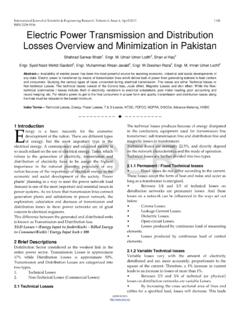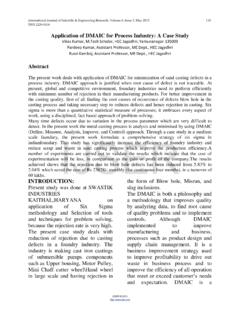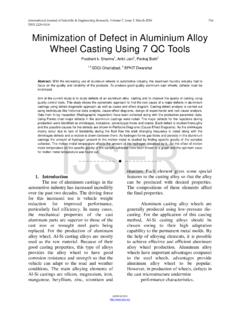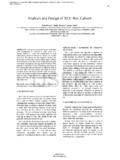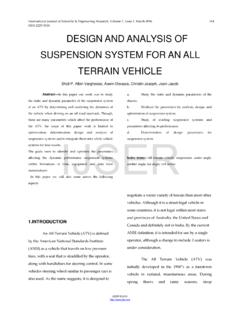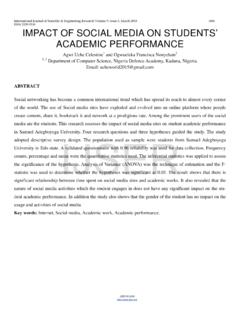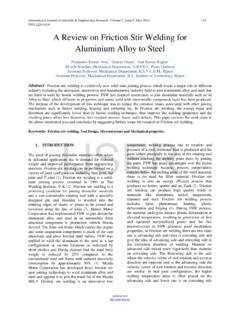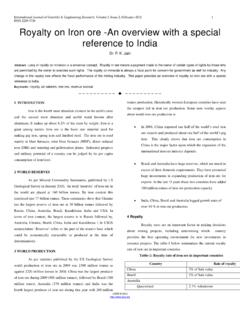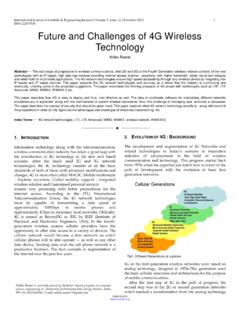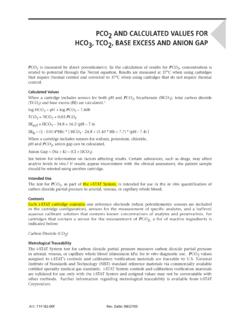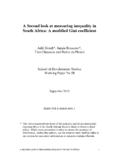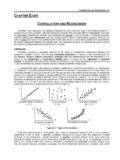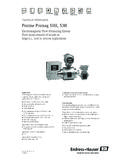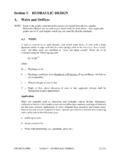Transcription of The Influence of Roughness on the Wear and …
1 International Journal of Scientific & Engineering Research, Volume 3, Issue 4,April-2012 1 ISSN 2229-5518 IJSER 2012 The Influence of Roughness on the Wear and Fric-tion Coefficient under dry and lubricated sliding Riyadh A. Al-Samarai1 ,Haftirman1,Khiarel Rafezi Ahmad2,Y. Al-Douri3 Abstract The aim of the present research was to the effect of surface Roughness of aluminum-silicon casting alloy on the friction and wear is inves-tigated. Various surface Roughness average (Ra) of different degrees were verified via different grades of grinding, polishing and have been evaluated using a pin-on-disc as well as three different loads 10, 20 and 30 N, speeds 200, 300 and 400 rpm and relative humidity 70%. Different surface prepara-tion techniques are resulted in different surface Roughness of (Ra) = (4,6) m.
2 The monitor effects on the friction coefficient and wear are through the test dry and lubricated sliding. It was noted that the weighted and volumetric wear rate decreases as degree of Roughness decreases, as well as coefficient of friction is considered as a function of the stability state. This paper attempts to bridge the gap between the damage mode, sliding conditions and surface Roughness to provide an approach to evaluate the surface finishing as a factor in friction and wear damage processes. Index Terms Surface Roughness , Lubrication, Dry sliding, Casting alloy, Coefficient of friction, Wear rate, Damage. 1. INTRODUCTION urface Roughness is a major problem produced during the production process and greatly affect the quality of the prod-uct [1]. Can affect the surface Roughness during the process of sliding through the contact between the surfaces at the Tops and this leads to cut and deformation these peaks during the slide and thus can cause economic damage so it is best to be a better under-standing of the Roughness [2] as well as affect the surface rough-ness coefficient of friction on the side by side with the frequencies and vibration incurred during sliding between the surfaces, and there are variables affecting the coefficient of friction when slid-ing[3][4].
3 Is important to know the quality of the Roughness of surfaces that require a process of coating and treatment to protect it from damage[5] That the installation and texture surface can increase the load hydrodynamic as well as increasing the thick-ness of film when the structure of surfaces of linear and moderate and thus increases the life of surfaces and reduce the cost [6]. of either rough surfaces usually lead to speed the process of wear and damage surfaces when working must take into account the mechanical properties and factors affecting when sliding between surfaces[7] .In these experiments we will notice the impact of this Roughness is actually a coefficient of friction and wear rate be-tween the surfaces sliding at the contact between the areas of no-minal and actual handling of this effect by carrying out treatments on the surface of the coating, and other processes that help in smoothing the surface and the things that affect the advance on the surface is the manufacturing process of the basic surfaces and the surface termination phase[8].
4 Menezes et al. [9].have been studied the effects of Roughness parameters on the friction of aluminum alloy under conditions of lubrication. They concluded that the coefficient of friction and wear are depending on the Roughness It is important to know the quality of the surfaces Roughness that requires a process of coating and treatment to pro-tect it of damage [10]. Karpenko and Akay [11] have been studied the effect of Roughness between two surfaces using an algorithm to calculate the coefficient of friction between them. They concluded that there is a flexible deformation and shearing resistance depend on external loads, mechanical properties and topography surfaces to give the approximate limits of Influence . To increase the process of wear and damaged surfaces, we must take into consideration the mechanical properties affect the process [12].
5 Chowdhury and Maksud [13] have been searched the effect of humidity on surface Roughness and found that the friction is very high at low Roughness and tends to be increased at high horizontal vibration. Wieleba [14] had been studied Roughness and stiffness of composite materials against steel and showed its effect on the friction and wear. Al-Si alloys have been studied interestingly, but did not take into consideration the Roughness study. Xing et al. [15] have been prepared the hypereutectic (wt pct) and Al-25Si (wt pct) alloys with various content of rare earth Er by conventional casting technique. They investigated the effect of Er on the microstructure and properties of hypereutectic Al-Si alloys using optical microscopy, scanning electron microscopy (SEM) as well as friction and wear tests and noticed an improvement of the anti-wear properties and the friction coefficient of the hypereutectic Al-Si alloys.
6 Finally, Li et al. [16] have been prepared and fabricated hypereutectic Al-Si alloys by hot extrusion. They investigated the tensile fracture me-S 1 School of Mechatronic Engineering, University Malaysia Perlis, Ulu Pau, Perlis, Malaysia 2 School of Materials Engineering, University Malaysia Perlis, 02600 Arau, Perlis, Malaysia 3 Institute of Nano Electronic Engineering, University Malaysia Perlis, 01000 Kangar, Perlis, Malaysia International Journal of Scientific & Engineering Research, Volume 3, Issue 4,April-2012 2 ISSN 2229-5518 IJSER 2012 chanisms using SEM and proved an improvement of Al-Si alloy and wear resistance due to silicon particles refining. In this work, to best of our knowledge, there is not available in the literature investigation of Roughness on the wear rate with sliding distance and velocity of Al-Si casting alloy, on the volume-tric wear rate and friction coefficient with normal load.
7 It was attempted to bridge the gap between the damages resulting from the sliding surfaces and surface Roughness effect on the friction and wear to provide an approach for evaluation the surface finishing operations. All of these are divided into the followings: Section 2 displays the experimental process, while results and discussion are given in section 3. Finally, section 4 concluded the obtained results. 2. Experimental Procedure For the purpose of this investigation, aimed at investigating Influence of surface preparation on Roughness parameters and correlation between Roughness parameters and friction and wear, A pin-on-disk tribological test rig was used for the investigation shown in Fig. 1 The upper specimen was a fixed (10 mm) diame-ter Al-16Si casting alloy Ra = (4,6 ) m, Hv= 12kg/mm2), on disc, made of AISI 1045 steel (Ra = m, Hv= 312 20kg/mm2), ,were tested.
8 The applied load was (10,20,30) N and the sliding speed, (200,300,400) rpm ( , ) m/s. be-fore the start of effective wear samples of aluminum silicon disc was cleaned and dried using cotton and acetone as the weight of the samples was measured using a digital balance and recording the values before and after the test in each test is calculated slid-ing distance. The wear tracks were observed by scanning electron microscopy (SEM) combined with energy dispersive X-ray spec-troscopy (EDX).Surface Roughness was also measured by a stylus surface analyzer, with the effective measure length mm and the cutoff length, The work hardening of contact surfaces due to the friction shear was identified by their hardness increase as determined by micro-Vickers indentation test. Fig. 1 Pin-on-Disc wear testing machine Chemical analysis was conducted for the aluminum-silicon casting alloy, also density, hardness and tensile strength are stu-died due to its widely used in industry, particularly in pistons as well as the cylinders, the resulted chemical analysis is given in the Table 1, and testing of mechanical properties are cleared in Table 2.
9 While the surface Roughness parameters (Ra) are calcu-lated in Table 3. Table 1: Compositional analysis of Al-Si casting alloy. Si Mg Cu Fe Ni Mn Sn Pb Zn Table 2: Investigated hardness, density and tensile strength of Al-Si casting alloy. Hardness VHN Density gm/cc Tensile strength 250 MPa Table 3: The calculated surface Roughness average (Ra) of Al-Si casting alloy. Reference surface Sample area Ra ( m) Sample 1 4 Sample 2 6 International Journal of Scientific & Engineering Research, Volume 3, Issue 4,April-2012 3 ISSN 2229-5518 IJSER 2012 The microscopic structure and the composition of microscopic samples are examined and shown in Fig. 2. It is shown that Si particles are distributed uniformly, while the Si seems a bulk, we have used the following materials manifesting: 190 ml of water distil 3 ml from hydrochloric 2 ml from hydrofluoric acid.
10 Primary Si particles Si Fig. 2 The SEM images of microscopic structures of Al-Si casting alloy. Al-Si casting alloy. Was cleaned then starting an actual test of wear process and the hard substance acetone with cotton and dry well was registered height and weight of samples accurately to provide a very precise and digital recording of all data using a stopwatch to set a time slip and post-test . Wear rate was estimated by measuring the mass loss in the spe-cimen after each test and mass loss, ( W) in the specimen was obtained. Cares have been taken after each test to avoid entrap-ment of wear debris in the specimen. It is calculated to the mass loss to sliding distance ( ) using: W/ (1) The volumetric wear rate Wv of the composite is related to densi-ty ( ) and the abrading time (t), using: Wv = W / t (2) The friction force was measured for each pass and then averaged over the total number of passes for each wear test.
